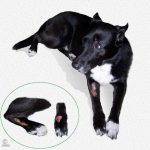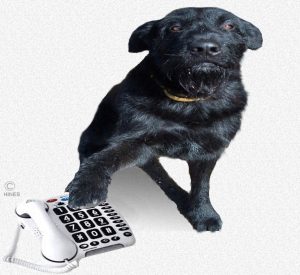Separation Anxiety In Your Dog And How To Treat It
Ron Hines DVM PhD



What Is Separation Anxiety?
Separation anxiety is a pet’s exaggerated fear over separation from its owners. Simply said, your dog is afraid of being left alone. Dogs are innately pack animals. For them, it is you and your family that constitute their pack. Take away their pack and they are unhappy. Dogs also live in the here and now. They have an imperfect understanding of time. Many never grasp that your absence will only be temporary – so fear, anxiety and dread of abandonment replace contentment. The extent to which these things occur and how long they last vary greatly from dog to dog. I will tell you more about separation anxiety in your dog and how to treat it.
During periods of anxiety, hormones associated with stress and fright are released by your pet’s adrenal glands (adrenaline, cortisol, norepinephrine). Those hormones surges elevate heart and respiration rate, increase intestinal motility (~diarrhea) and can cause vomiting. The bonding hormone, oxytocin, is probably also involved. Sensitivity varies from breed to breed and dog to dog. When it comes to diagnosing separation anxiety, you, not your veterinarian, are the best person to recognize it in your pet. After all, you know your dog’s personality best. Many destructive, bizarre or annoying dog behaviors that are written off as simple boredom or health issues probably have a measure of separation anxiety in them. I believe that separation anxiety accounts for much of the reason ill and injured dogs often recover faster at home than when hospitalized.
Separation anxiety occurs equally in male and female dogs, unneutered dogs and those that are “fixed”. Some vets believe they see it more in the long nosed (dolichocephalic) breeds, bred for herding and guarding. Some dog behaviorists associate it with a traumatic “childhood”. I cannot say. High-strung breeds associated with obsessive compulsive disorders are probably more at risk for separation anxiety as well.
Dogs prone to separation anxiety are going to have their good days and their bad ones, good periods and bad periods. Often that will be in response to environmental causes that are not apparent to you or me. Dogs with the problem tend to do best with very fixed (rigid) daily routines. Concentrate on providing anxious pets a consistent home structure and daily interactions and feeding routines that remain constant in their timing and content.
Smells play a considerably more important role in a dog’s feelings of security and happiness than they do in yours. Kitchen odors can be very comforting when you must leave. Your scent on worn clothing just as comforting. Their flare-ups often coincide with an increase in household stress. Dogs are experts at perceiving stress, annoyance and discomfort through your voice, your posture and your facial expressions. With their acute sense of smell, they probably identify many mood-related compounds people emit. They are less capable of understanding that your annoyance is not directed toward them.
Older pets with separation anxiety, like older people, can have difficulty moving to new homes, accepting new pets, new babies and new situations in general.
Separation anxiety is not the same thing as boredom (although both can be involved). Boredom can also result in chewing, pawing, digging, and other negative or destructive behavior. Separation anxiety begins as soon as you leave, boredom only after an hour or two. All puppies show some signs of separation anxiety. It is natural in the infants of many species. But as time passes, normal puppies show these signs less and less and become more confident about being alone. By the time they are “teenagers” they should be free of their puppyhood dependency and insecurity.
What Might Be Some Signs of Separation Anxiety In My Dog?
The signs are much the same as in human panic attacks. Learned behaviors are forgotten, judgment is impaired, and remaining behaviors are exaggerated. Here are some:
Exaggerated Grooming Behavior
Grooming is a very important activity for your dog. For them, it is a very pleasurable experience. Grooming is often exaggerated when pets are anxious. That can be to the extent that skin damage and ulcer’s occur. Those can progress to lick granulomas.
Destruction of Furniture And Woven Material
I cannot tell you what is going through your dog’s mind when it begins ripping up objects. It is a natural play activity of puppies, but it is also a common occurrence in dogs experiencing anxiety attacks.
Eating Non-Food Items Toys and Clothes
I have extracted everything from socks to loose change from dogs that experienced the anxiety of being left alone. I cannot explain why that occurs so commonly. Dogs with access to the yard tend to ingest stones, leaves and twigs in the same situations. The indigestion (and occasional surgery) that those actions result in is never associated by the dog with the things it has eaten. Left in similar circumstances again, they will repeat what they did.
Loss Of Potty Training
Again, a common occurrence in anxious dogs.
Barking
Barking can also be a sign of separation anxiety. Occurring less commonly, separation anxiety in some dogs results in over eating or under eating. Some dogs twitch, some hide, some pace. In some dogs, these behaviors get worse as they approach their senior years and can be mistaken for cognitive decline (doggy Alzheimer’s).
What are Some Other Non-Drug Therapies That Might Help My Dog?
Non-drug therapies for your dog are always preferable to medications. Sometimes those non-drug therapies are all that is required. Other times, they assist your veterinarian in lowering the dose or frequency of medications that must be given. It can be very hard for you, the dog owner, to size up where changes need to be made. An experienced canine “psychologist”, dog trainer or even a close friend who is not emotionally involved in the bond between you and your dog is considerably more likely than you are to see changes that need to be made. A friend who knows your lifestyle and limitations is most likely to avoid suggestions that are just not realistic for you. Positive reinforcement techniques teach your dog that it does not have to be fearful and panicky when it is left alone. That being alone is not such a bad thing. Pet owners do this by rewarding desirable behavior and ignoring bad behavior.
“Cognitive Behavioral Therapy” has four components:
1) Learning to recognizing anxious feelings in your dog early.
2) Reassuring your dog in anxiety-provoking situations.
3) Developing a plan for coping with these situations when they occur.
4) Evaluating the success of the new coping and behavioral therapies as you go and modify your approach accordingly. Trial and error are the name of the game.
Some dogs only require a smaller space, their “crate” or den, to ease their fears when you must leave. It doesn’t work for all dogs. If your pet panics when you attempt to crate it, don’t force it in. It will just make the situation worse. Some people, including me, have problems accepting the crating of their dog. Your dog can sense that and may resist do that that fact alone. Crating can be a quick “fix” that prevents destructive behavior. But it can do so without relieving the underlying anxiety your dog experiences. Save crate options for last.
What Are Some Other Practical Steps I Can take To Minimize Separation Anxiety, Make My Pet More Confident And Less Dependent On My Presence?
1) Teach your dog as many commands as possible. Your pet should be able to “sit” “relax” and “stay” on command while you stroke and reassure it. One of the best ways to accomplish this is to join a group obedience class. Each member of your household should participate in a “take charge” way because it is impossible to have happy, well-adjusted family pets if family members are below a pet in the household “peck order” (social order). The point of this training is teaching anxious dogs to relax and give them confidence. Do the exercises in various rooms of the house and in the yard. Give out praise effusively and chew treats liberally for a job well done.
2) Find a room in your house that is not easily destroyed. Place the dog in it with some of his favorite toys and stay with him a while. Then leave and shut the door promptly without fanfare. When you return, a few minutes later, give him a pat, a hug and his favorite food treat. Over many days, repeat this; but each time stay away a little longer. You may leave a radio or television playing but be careful about electrical cords. (The technical term often used for this is Graduated Exposure or desensitization)
3) Dogs know when you are thinking of leaving long before you do. Perhaps it was because you put on your shoes, picked up your purse or car keys or put on your dress clothes. If you can determine what the clues are that you give your dog, you can try to desensitize the pet to these clues by repeating them frequently but not leaving and by giving the dog a treat and praise when it behaves well. When you have made progress, make your departures quiet and quick. (The technical term often used for this is Contingency Management or unlearning)
4) Some feel that diet might play a part in separation anxiety. There is no harm in offering your pet one of the “Calm®” diets that leading manufacturers of pet foods now offer -, although none of them have been scientifically verified to be effective. Sprays containing pheromones are also available – although the value of them too has never been verified.
5) In some pets, you can reduce dependency by spending less time with them for a training period of several weeks or months. That means less eye contact, less verbal praise and less comforting, fewer commands and less scolding. Something many of us just would not be comfortable doing. During these periods, it is said that the dog should not be allowed to sleep in your bed or bedroom. While doing this, one never supposed to “reward” unwanted behavior by making a scene, scolding or interacting with the pet. Always being mellow with the pet – based on the theory that mellow people tend to have mellow pets. The purpose of all this is to make the pet more self-reliant. (The technical term often used for this is Response Prevention) I am no big fan of this.
6) There are mixed thoughts about the benefits of having a companion pet for your pet. Some say this may help the situation and others say it will make the problem worse. I have not personally seen this approach work. It will overcome boredom, but its other effects on the household are unpredictable.
Other Strategies
As I mentioned before, try not to make your departures a big production by hugging your dog and cooing over it because you are guilty about leaving. That tends to only make the problem worse. Try leaving stealthily through a back or side door. Departures should be quick and quiet. The family should ignore the dog for about 20 minutes before you leave and 20 minutes after you get home. Dogs need vigorous exercise once or twice a day. A good plan is to take them for a walk or jog an hour or so before you leave for work and then give them 20 minutes or so to calm down before you leave.
What Are The Medications My Veterinarian Might Use To Treat Separation Anxiety?
I suggest that drug therapy not be used until you have attempted some of the non-drug therapies listed above.
Some preliminary veterinary research suggested that selective serotonin reuptake inhibitors (SSRIs) might provide some help for separation anxiety disorders and other anxiety disorders of dogs and cats. Veterinarians often key their therapies from those used in humans when choosing medications. But neither tricyclic antidepressants like Elavil® nor benzodiazepines such as Valium® (diazepam) have been shown to be more effective than placebos in children. Some veterinarians still do prescribe them for disturbances thought to be anxiety related
Diazepam (Valium®)
Although this medication can be helpful for a number of problems in cats. My experience is that it is not helpful in dogs. It and more modern medications in its class, are frequently prescribed for humans with various anxiety issues. But even in people it is never recommended for long-term use.
Amitriptyline (Elavil®)
This medication is an old tricyclic antidepressant. I have not found it helpful for dogs with anxiety issues.
Clomipramine (Clomacalm®, Anafranil®)
Clomipramine is one of only two FDA-approved medications for use to treat anxiety in dogs. It appears to be helpful for some dogs, but like the other approved product Fluoxetine (Reconcile®, Prozac®) it is rarely helpful if behavior therapy for the pet is not begun as well.
Fluoxetine (Reconcile®, Prozac®)
Reconcile is the same active ingredient as Prozac – but in a once-a-day chewable flavor tablet designed for dogs. As with Clomacalm®, it is rarely effective in itself but may increase the effectiveness of behavior modification therapy. There are a number of commonly used dog medications that interact with Fluoxetine. So read the label before giving it to your dog. Regarding the flavortabs, dogs seek them out and eating a larger number than your veterinarian prescribed can be toxic.
When these medications help your dog, you will probably notice other positive changes in your pet. They are often less tense, more carefree, enthusiastic, and less depressed. They may get a bit pudgy since some of these meds increase appetite. Don’t feel guilty about using these medications under your veterinarian’s guidance. There’s no stigma attached – you’re just treating a brain hormone imbalance. Also, try to be content with improvements – not total makeovers.
Are Some Of These Problems Rooted In My Pet’s Genes?
Yes
The Broad Institute has made great progress in mapping the complete gene catalog (genome) of dogs. They have also made great progress in understanding which genes favor compulsive and aggressive behavior in dogs. That does not mean that love, patience, training and/or medication cannot improve your pet’s situation. It might also help you to understand that we pet owners, and our pet’s earlier traumas might not be entirely responsible for our pet’s current psychological issues. Many pet owners who write to me feel that guilt and frustration. There is no real reason for you to feel that way. I tell all my clients not to and reinforce that every time I see them. I wrote this article to give you some ideas on separation anxiety in your dog and how to treat it
You are on the Vetspace animal health website
Visiting the products that you see displayed on this website help pay the cost of keeping these articles on the Internet.

